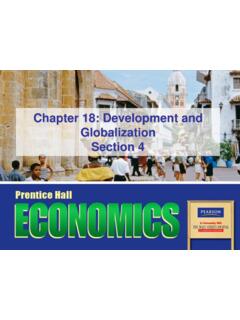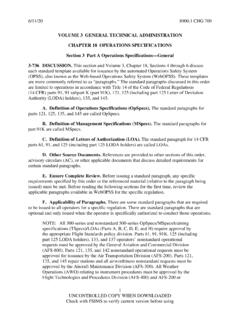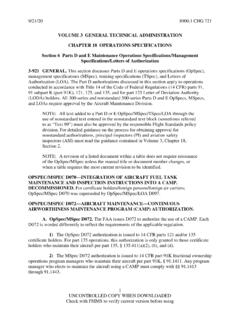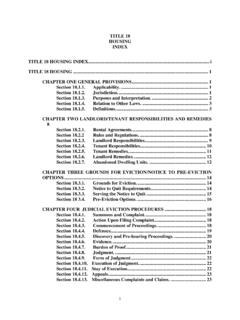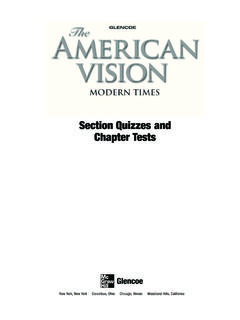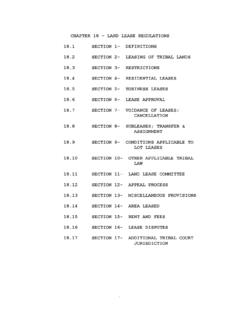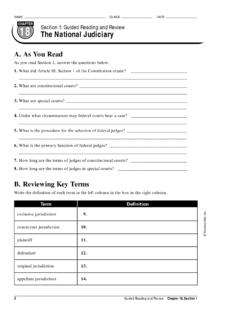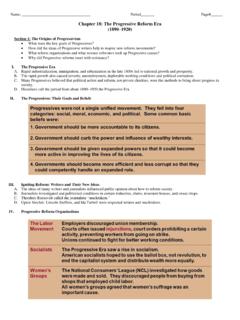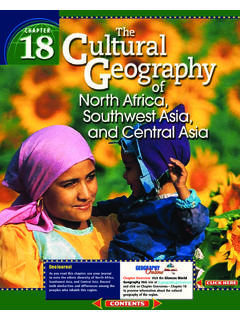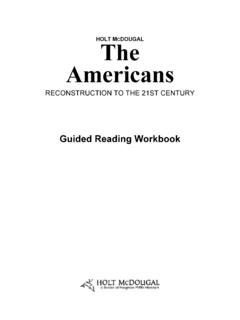Transcription of Chapter 18: Development and Globalization Section 3
1 Chapter 18: Development and Globalization Section 3 Copyright Pearson Education, Inc. Slide 2 Chapter 18, Section 3 Objectives the characteristics of economic transition. the political and economic changes that have taken place in Russia since the fall of communism. the reasons for rapid economic growth in China and India. the economic challenges facing Africa and Latin America. Copyright Pearson Education, Inc. Slide 3 Chapter 18, Section 3 Key Terms privatization: the sale or transfer of government-owned businesses to individuals special economic zones: designated regions in China where foreign investment is encouraged, businesses can make the most of their own decisions, and foreign companies are allowed to operate Copyright Pearson Education, Inc. Slide 4 Chapter 18, Section 3 Introduction How has economic change affected different countries?
2 Russia shifted from a communist state to a free market economy to become the world s ninth largest economy. In China and India, making the change to free markets have led to economic growth. The transformations in both these countries, though, are still in progress. Africa and Latin America still face many challenges and few nations on either continent have been able to develop a totally successful free market economy. Copyright Pearson Education, Inc. Slide 5 Chapter 18, Section 3 Privatization For many nations economic transition has meant moving from central planning to a market-based economy. One of the first steps in moving to a market economy is to sell or transfer government-owned businesses to individuals. This process is called privatization. In China, the transition from strict communism to free market practices has given rise to a new generation of entrepreneurs, such as this store owner.
3 Copyright Pearson Education, Inc. Slide 6 Chapter 18, Section 3 Privatization, cont. A government can privatize businesses by: Selling the business to one owner Selling shares to investors Giving citizens a voucher to purchase shares in businesses once they are privatized Privatization can be difficult. Many people will lose their jobs because they are no longer guaranteed by the government. Another result of privatization is corruption, which leads to an unfair distribution ownership. Copyright Pearson Education, Inc. Slide 7 Chapter 18, Section 3 Transitioning Economies Moving to a market economy requires changes in the legal system. The government must create new laws that ensure a person s right to own and transfer property. Such an overhaul of the legal system takes time. Workers in a transitioning economy also need to lead a new work ethic as incentives, not quotas motivates people s labor in a free market.
4 Many people accustomed to central planning might resist the shift to the free market out of fear and uncertainty. Copyright Pearson Education, Inc. Slide 8 Chapter 18, Section 3 The Fall of Communism Checkpoint: How did communism end in the Soviet Union? When the Soviet Union fell in 1991, Russia and the other former Soviet republics began the difficult transition to a free market economy. Under communism, government planners directed the Soviet economy, which led to frequent shortages and low-quality goods. In the late 1980s, Mikhail Gorbachev began to move the Soviet Union toward a more free market economy. Copyright Pearson Education, Inc. Slide 9 Chapter 18, Section 3 The Fall of Communism, cont. The transition to free market economics created problems. People lost secure government jobs, benefits, and pensions. Many people were hurt financially and unrest grew.
5 One by one, the 15 Soviet republics declared independence. Copyright Pearson Education, Inc. Slide 10 Chapter 18, Section 3 A Painful Transition Russia s new president, Boris Yeltsin, promised rapid progress towards a free market economy. Despite improvements, hardships continued. Inflation increased There was an uneven distribution of income Corruption was rampant By 1998, the Russian economy was in shambles. Copyright Pearson Education, Inc. Slide 11 Chapter 18, Section 3 Russia in a New Century Tight controls from the central government, combined with rising prices for Russian oil, allowed Russian leaders to stem the crisis. By 2007, Russia had the world s ninth largest national economy. Still, problems persist and the transition to a market economy is far from complete. Copyright Pearson Education, Inc. Slide 12 Chapter 18, Section 3 China China is a major exporter of goods and a key trading partner of the United States.
6 In 1949, communists led by Mao Zedong took power in China, putting communist policies in place. In 1976, Deng Xiaoping became China s new leader. Deng began using free market policies to increase productivity. He used incentives to increase production. He gave farmers and factory managers more freedom. He set up four free market centers along China s east cost, which increased foreign trade and investment. Copyright Pearson Education, Inc. Slide 13 Chapter 18, Section 3 China, cont. These economic changes have led to huge economic growth. Still, Development has brought its share of problems. Increase in crime and pollution Jobs are no longer guaranteed Poverty and unemployment plague rural areas Economic Development has not meant political liberty Copyright Pearson Education, Inc. Slide 14 Chapter 18, Section 3 India A former British colony, India struggled economically after gaining independence.
7 In the 1990s, new policies encouraged Indian companies to expand. Many software companies opened new facilities in India, where educated workers could offer technical support to computer users around the world. Economic growth helped promote the emergence of a much larger middle class, which provided a growing market for consumer goods. Copyright Pearson Education, Inc. Slide 15 Chapter 18, Section 3 India, cont. As with China, India s growth is not complete. There is a growing gap between the richest and poorest citizens, which is true in virtually all nations with developing economies. Urban dwellers with educations and skills benefit the most from growth. Uneducated people in poor rural areas struggle with poverty and continue to rely on subsistence farming. Copyright Pearson Education, Inc. Slide 17 Chapter 18, Section 3 Persistent Poverty in Africa South of the Sahara, most African nations face economies largely based on subsistence farming with low literacy rates, inadequate health and nutrition, high rates of HIV infection, and mounting debt.
8 Civil war also plagues many nations. Only two African nations south of the Sahara have sizeable economies Nigeria and South Africa. Copyright Pearson Education, Inc. Slide 18 Chapter 18, Section 3 Nigeria and South Africa Nigeria benefits from large oil reserves yet suffers from overproduction, political corruption, and ethnic conflict. New leaders promised to improve the economy and standards of living. South Africa has one of the 25 most productive economies in the world despite high unemployment rates, poverty, and high rates of HIV infection. Still, South Africa benefits from a rich array of natural resources and a strong manufacturing base. Copyright Pearson Education, Inc. Slide 19 Chapter 18, Section 3 Different Paths in Latin America Checkpoint: What countries in Latin America have built the strongest economies? Brazil exports iron ore, timber, coffee, and soybeans.
9 It also produces ethanol made from sugar cane. Mexico produces rich crops of cotton and coffee and has diversified its economy by promoting tourism. Copyright Pearson Education, Inc. Slide 20 Chapter 18, Section 3 Review Now that you have learned how economic change has affected different countries, go back and answer the Chapter Essential Question. Do the benefits of economic Development outweigh the costs?
